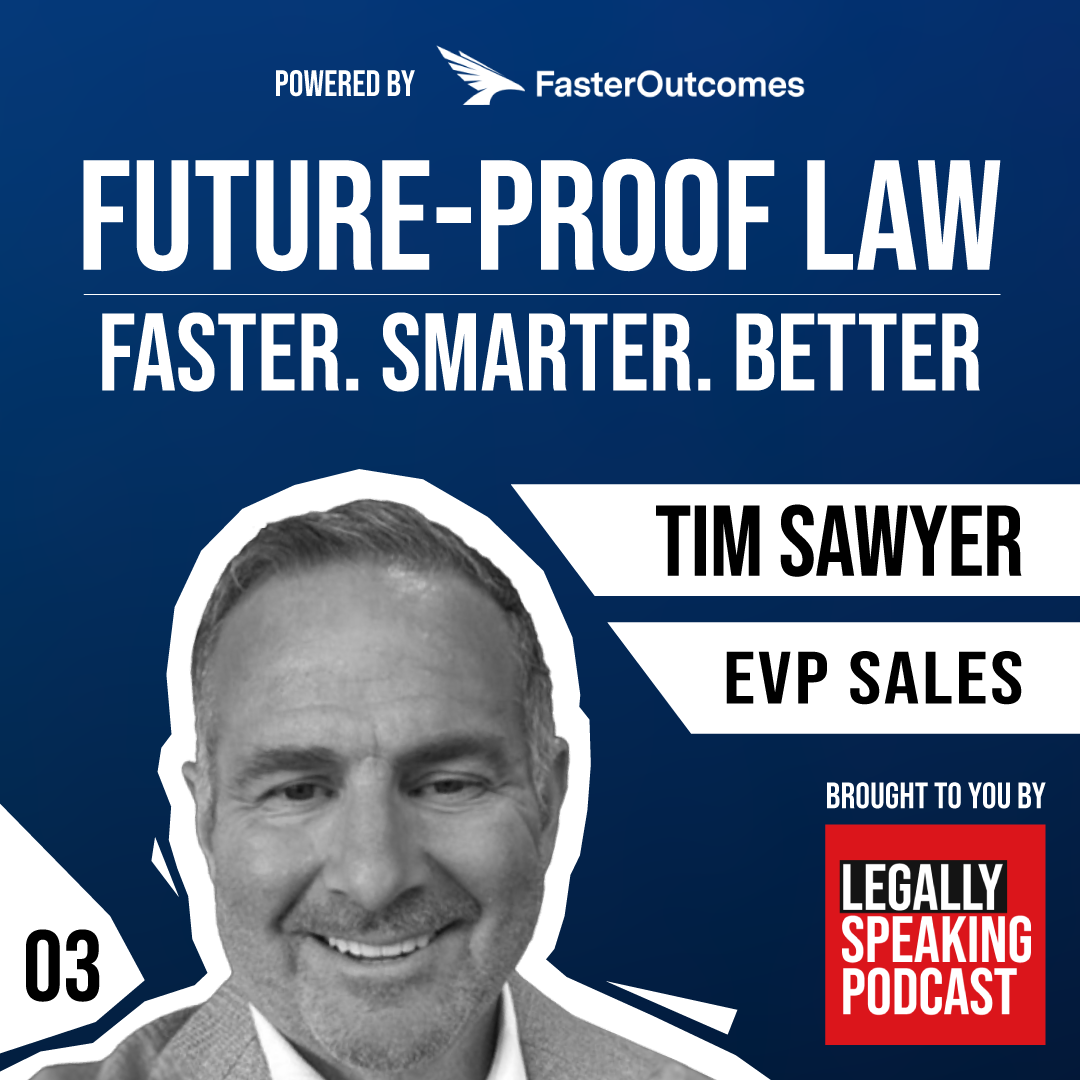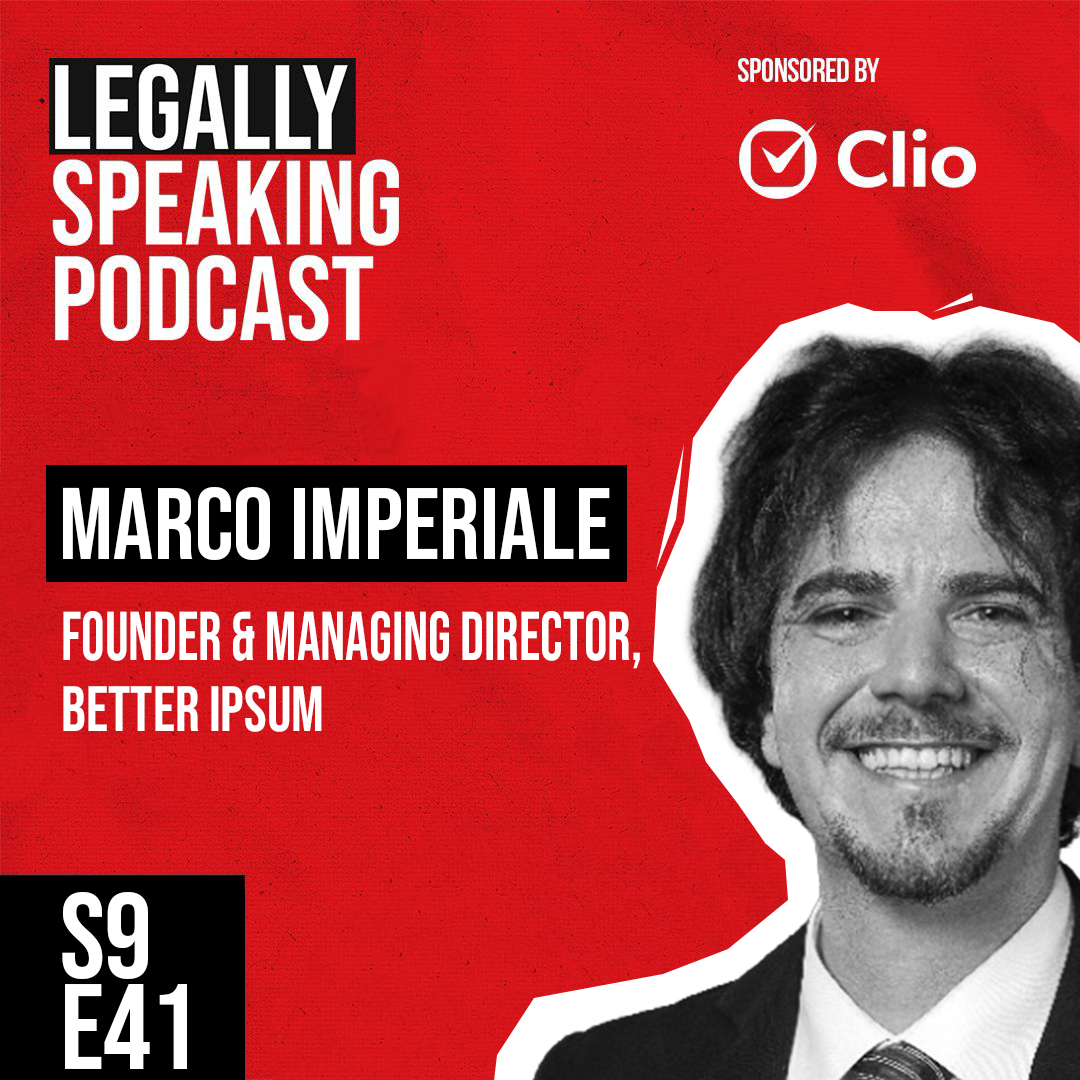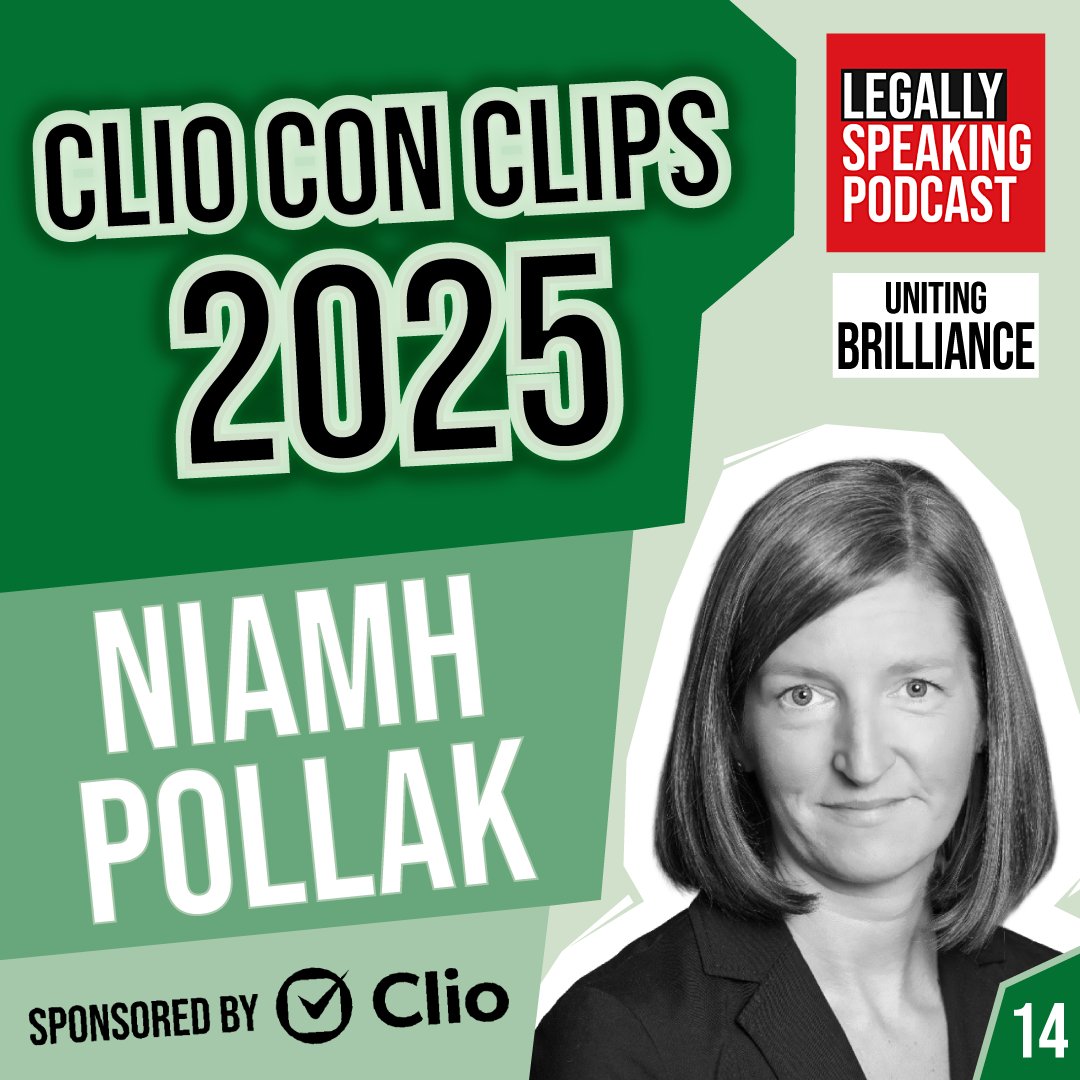
The Great Big Legal Offsite (GBLO) 2026
Event Overview:In 2024, the Legally Speaking Podcast and HiveRisk founded a unique law firm leadership strategy

Welcome to our final episode of the “Future-Proof Law: Faster. Smarter. Better” miniseries – powered by Faster Outcomes & brought to you by the Legally Speaking Podcast!
This Faster Outcomes series features three short, power-packed episodes with trailblazers from the AI and legal tech space — designed to equip law firms with the insights they need to adapt, innovate, and win in an AI-powered future.
So what’s it all about?
Each 10–12 minute episode breaks down real strategies, tech trends, and client-first transformations that are redefining the legal landscape.
In this last episode, we talk to Tim Sawyer, the Executive Vice President Executive of Faster Outcomes. Here, we dicuss a key topic in the world of legal tech, how future law practice will be carried out by companies and individuals. Be sure not to miss this captivating discussion!
You can hear Rob and Tim discussing:
– Implementing an Effective AI Adoption Strategy
– The Role of Leadership in Understanding AI
– The Transformation of Modern Law Firms
– Maintaining Human Touch in a World of Evolving Legal Tech
– Why Companies Should Give AI a Proper Try
Connect with Tim – https://www.linkedin.com/in/sawyertim
Robert Hanna 0:00
Welcome to future proof law, faster, smarter, better mini series powered by faster outcomes and brought to you by the legally speaking podcast. We’re back with another cutting edge mini series, and this time we’re diving head first into one of the hottest topics in legal innovation, agentic AI, this faster outcome series features three short, power packed episodes with Trailblazers from AI and legal tech scenes designed to equip you law firms with the insights you need to adapt, innovate and win an AI powered future. So what’s it all about each 10 to 15 minute episode breaks down real strategies, tech trends and client first transformations that are redefining the legal landscape. So let’s get into it. To close out our legally speaking podcast, future proof law, faster, smarter, better, mini series, we’re zooming out and looking ahead. Legacy doesn’t mean being left behind. It means leading differently. As AI reshapes legal from inside out, the firms that endure will be those evolve without losing their identity. Today, we’re exploring the top trends defining the future of law firms and how leadership can keep pace. Here to share his expert perspective on what’s next for this true is a true visionary. So Tim Sawyer is the EVP of sales at faster outcomes. So a very warm welcome to the podcast, Tim.
Tim Sawyer 1:22
I am so happy and grateful to be here today. Can’t wait to get into discussion. Let’s do it
Robert Hanna 1:28
absolutely and we’re honoured to have you. So let’s get into it. Tim, as you say, what do you see as the most disruptive trends coming to law firms over the next one to five years? In your
Tim Sawyer 1:39
opinion, what I see as the most disruptive trend. Obviously, we’re talking about agentic AI primarily. Yeah, that’s going to be a huge driver. The firms that are going to win, where there’s going to be real disruption, are firms, when we talk about leadership, that can connect with their why that’s the start, right? So there’s a lot of talk about AIS, talk about AI implementation, and we can get into workflows and those types of things. But I think from a leadership perspective, if we step back and we take the anxiety out of it, we just say, first, what are we trying to accomplish with AI? Let’s start there, and then, I think from an adoption standpoint, because this is the trick, Rob Right, is leadership needs to get on the same page and say, This is what we’re going to do. This is why we’re going to do it. They need to help the team understand that and then take the anxiety out of the adoption phase. And I think some simple things that we can do is connect with our team and say, Okay, have you used open source chat GPT. What do you use open source chat GPT for? And then show them some simple use cases that they can, by the way, create a children’s book, write a poem. Just get comfortable using the technology. So then you go from Curiosity, from anxiety to curiosity, curiosity to adoption on a personal level. And then we work together as a team to bring AI into every element of the law firm, right? And the way I always talk about it is, let’s break the law firm down into three parts. We need to engage, so all the elements under engage, right? So that’s intake marketing. There’s a lot of things that we can do with AI there. How do we provide a world class advocacy and client experience that leads to the highest settlement, that we can break that down into bite sized pieces, and then, as Andrew was mentioning, how do we use our existing database to continue communication post settlement so that we can curate five star reviews we can generate referrals, so it’s engage, assist and scalable growth, but it all starts with why, and then a slow, easy movement towards adoption. And if the law firms who can nail that motion are going to kill it. Yeah,
Robert Hanna 3:54
and I love that. And I love that you talked about slow motion, because it’s not always that you need to rush to these things. And I had someone that I spoke to recently said, you know, with with AI adoption, it’s almost like trying to drive in the fog, you know, continue driving, but maybe you just go a little bit slower because it’s foggy. You can’t see fully ahead. But the main thing is, you keep going forwards, and you stay curious, and, like you say, you learn, and you look to adopt and and try and move with these things. Yeah. Really liked how you broke that down and gave some bite sized examples there. So again, we spoke to in Rishis episode, which was episode one of this mini series around human touch. So I want to come to you in terms of how law firms can scale with AI. If we’re saying AI is for good, but without losing that human touch, or indeed the legacy that makes them so unique, if you
Tim Sawyer 4:35
deploy AI correctly, and again, this adoption phase, if everyone gets comfortable with AI as a friend, not this intimidating technology, but as a friend, and we develop a personal relationship with an AI agent as we implement these initiatives in the law practice, we can use AI to actually. Uh, further develop the brand, right? So think about the average law firm, and what they say, right? In terms of human touch, you get them on stage, and they say, Well, Tim, the reason my law firm is different is I’ve been in the community for 30 years. I do philanthropic activity. I go to church on the weekend. And then the next law firm, the next lawyer, stands up and he says, What? Exact same thing, right? So, brands are built from within, and what AI can do is help establish the why of the firm, right? What makes us great? And there’s just simple tools that you can use AI just to help you understand, and I always like to say so, for example, from a branding perspective and human touch, if let’s use AI to create a poll, and that poll is, if we have 10 team members in this law firm, let’s put them all in a separate room and ask them give me three sentences on why choose our law firm. What is the likelihood that all of those people would say the exact same thing? Not very high, right? So you can utilise AI for training, for script writing, for further development of the brand, getting everybody on the same page. And that’s what leads to human touch, right? It’s people are confident in what the brand is. And then you can automate things like client communication. Then you can start integrating text modules and obviously, email. So I think AI, it can enhance, and all these things are not designed to replace. It’s designed to enhance, and it helps law firms organise their thoughts. So again, if they break down, okay, what is, what is our brand really? Right? What do we mean to this community? And then use AI to train. So for example, notebook, right? Notebook is an unbelievable training tool. So you can, once you establish, get set up some meetings in in notebook, say, once you get to a brand, and then people don’t realise you could actually set use those standards to create a podcast or an audio script inside notebook to train the team. So AI is once you can define why am I doing this? So if the app, if the goal is, well, the reason why I’m doing this is we want to make sure we’re tight on our brand. We want to make sure everybody understands the talk tracks. We want to make sure that we’re automating all the communication, that we don’t lose any contact with anyone you can, it’s the greatest brand human touch tool in the world. And
Robert Hanna 7:24
it’s so true, isn’t it, you talk about enhancing there and to that point of culture and having people in different rooms, if you can educate and inform and enhance what’s there, again, not to to like. And I guess that leads nicely onto my next question. In terms of, we hear a lot about the modern law firm, but what does that actually mean in an AI legal first world, in your opinion,
Tim Sawyer 7:43
the modern law firm. And I’m going to keep going back to this point, because I think it’s number one. What stops people from getting the most out of AI? It’s getting comfortable with the technology, taking out the intimidation. To your point, scroll, walk, run, adoption on a personal level, and then adoption at the corporate level, right? And so the Modern Law Firm, we like to say, AI is not going to replace lawyers, but folks who are really good at AI are going to replace lawyers who aren’t and at a high level rob the pressure is going to come from the consumer. So what does the modern law firm look like three to five years from now? There’s all markets become more efficient eventually, right? So this established billable hour model? Do I think that’s going away? No, but I think consumers are going to be more educated, particularly at the higher corporate level. Like, if you’re representing Coke and Pepsi, they have aI too, right? And they’re looking at forms and templates that you’re creating going 15,000 for that document. I don’t know Mike, like, let’s let’s not do that. So I think what the modern law firm is going to look like is understanding the landscape in its entirety, what the larger impact is going to be on AI, and it’s going to start with price pressure. So two years ago, if you asked a lawyer, hey, you’re not using AI, are you? No, no, no, no, no. And of course, they’re all using AI at some level. Right now, the new law firm is going to look like when their potential client says, Hey, you guys are using AI, right, of course, and they’re going to have to bake that into how they serve. And what will happen is the pricing models, whether it’s billable hour or subscription, or in the case of, you know, personal injury, contingency based some there’s going to be pressure, and consumers typically drive the change. And so law firms that embrace that pressure, that that education, that awareness, are going to be amazing. It’s the law firms that go, You know what? We’re just not doing that. Well, if you don’t have some type of blended model. To fix pricing, then I think it’s it’s going to cause pressure, right? Look at any industry in the world, they all become more efficient eventually. And what’s the ultimate leveller is? Ai, right? Because it makes the average lawyer a super lawyer. Makes the average doctor a Super Doctor. Levels the playing field. And so as the level field, the playing field, becomes levelled, we’re going to have to adopt, to adapt. We have to be adaptable. And law firms need to get out of this idea that this is the way we’ve done it for 300 years, and it’s never going to change. That ship is sealed, and they need to be adaptive. So that’s what I think it’s going to be driven by the consumer. There’s more power through education. We have more tools to get knowledge than ever before, and we got to address that for sure. That’s the elephant in the room. In my opinion, the whole pricing model is going to be a big change.
Robert Hanna 10:52
Yeah, and you’re right. And look in business, the only constant is change, and you need to be adaptable to that. So I absolutely agree. And you know, one thing that I’m passionate about is leadership. I’ve been recruited for nearly a decade in of law firms of all size around the world, and one of the common reasons people are looking for new roles is due to a lack of leadership or poor leadership. And for me, I hope AI for good when it comes to this, help improve and enhance cultures. But I would love to get your perspective on what role do you see leadership playing in the shaping of an AI positive culture inside law firms.
Tim Sawyer 11:25
I think that the first role to your point is not, not to get caught up in the rush of conversation, right? So if you get anxious because everyone’s talking about AI and you start the most important thing leaders in law firms need to do is avoid comparative living. And by comparative living, I mean, look to their right, uh oh, they’re going really fast. We need to go really fast. Uh oh, they just did this. We need to do that. That is the worst thing that you can possibly do, is comparative living. You have to start with your why, what’s our identity? And then again, start to figure out how we can slowly plug AI into each step along the way, right from intake to call analysis, right? That’s a big, important part leadership has to work with each group and say, Okay, these are the clear expectations that we have. This is what I see as your role and relationship with AI. This is what I see. As you know, break that down into bite sized pieces. Leaders need to step back, not rush, take their time. And if we do that, keep sticking to the why. This is why we’re doing this, and then show them the benefits, right, the benefits. And I also think, you know, it’s interesting. I was on a conversation with the COO of a large law firm. We got through the demo, and she said, Oh, so this basically does my job. Yep, right. So leadership needs to understand that there’s a lot of anxiety amongst the team members that wait. Why would I want to implement this? If I implement wait? So they we have to be real clear in our communication that we’re not in any way trying to replace anybody. We’re not trying to decrease. What we’re trying to do is go faster and you. I love the word I heard you use, the phrase I heard you use. This is a workforce multiplier, yep. So team, what we’re looking to do is create more time to do things that are more productive than these redundant, repetitive tasks that are time sinks. So if the messaging is right from leadership, if we take an individual approach, make sure that every team member understands how AI is going to they’re going to work within AI, to go faster, not to reduce their hours, or to eliminate them. I think those are the biggest barriers from a leadership perspective. Is just everyone’s going to calm down, like, I get this, you know, there’s this, like, chaotic feeling when you go on the floor, convention floor, and I got to use AI for this, and I got to use it. I’m like, Why? Why do you need to do that? Yeah, well, my friend, you know, stop blinders on. This is who we are. This is our identity, and this is how we’re going to use AI. This is why we’re going to use AI, and this is the outcome that we expect. And if we take that approach, we’re going to be in a great spot. If we take this, you need to read this, and you need to study this, and you need to get on chat GPT, and you need to, you need to, they’re going to shut down, right? And leaders cannot grow with AI without the team buy in. And you got to get total team buy in. And the last thing I’ll say is what we can’t do, and this will be particularly in mid to larger law firms, you’ll have your AI stars, and so they’ll be like, well, Susan can do it. Why can’t you just do it? Because Susan can do it. We have to stop that too, right? We have to show them, and then work with them and say, Now show me. And then let’s do it together. And if we take that approach home run, if we try to drive this down the roads around. Organisations without explanation and understanding everybody’s okay. This is to, like you said, go faster, multiplier, we’ll be fine.
Robert Hanna 15:09
Again, it just talks to, you know, I love how you kind of give that, you know, togetherness. And it reminds you of a mentor said to me, you know, we is greater than me. And I think that’s so true in this context as well. And you know, again, making sure they understand the benefits everyone’s favourite radio station, W, I, T, F, M, what’s in it for me? And I think if you can articulate that and how that impacts, then to the why or what they’re doing and the value it’s bringing to the firm in your direction. I think your point as well, of always going back to the white keeps you unique as well. I think if you’re just looking to the right, looking to the left, and you’re looking to maybe try and adopt what others have done, how does that make you unique? How does that make you stand out? So I love that point. Okay, one quick fire question before we we close. Really enjoyed today’s discussion. Tim, if you were advising a managing partner today of a law firm, what’s one non negotiable action they should take to future proof their firm? You
Tim Sawyer 15:53
know, I sound like a broken record. I would say, I think what you need to do is go in a room and think through, why are you doing this? What are the outcomes that you’re trying to achieve? How are we going to set up ways to measure progress towards that goal and a commitment to that you’re not trying this? Someone will say, you know, they’ll say, Well, sure, Tim, give us a month and we’ll try it. Might absolute, non negotiable would be, we’re not trying anything, because if you try it, the likelihood that you’re going to be successful is, is not very high. But if you go into it intentionally and say, and I would say, and we do say, in these larger projects that we work on. We’re going to spend 50 hours figuring out the who, what, where, when, and, most importantly, why. And if I can get them to connect with that on a personal, emotional level, and then get buy in from them, I’m in. But if it’s you know, for example, I say, Well, we’re going to do this. Well, Susan handles that part of the practice. So work with Susan No, because if you don’t believe, she’s not going to believe. And my thing is successful implementation of AI across the organisation. It all starts with belief. So the leader has to believe that if they go through the pain, if they walk through the eye of the needle, deliberately and intentionally, the results will be transformative, and we’ve seen that transformative results. But if you’re looking to use a widget, a gadget, a trinket, to save $4 on the production of a demand letter, I’m not your guy, right? Let’s do something worth doing, which is never easy.
Robert Hanna 17:41
When I first set up my legal recruiting business into a lot of entrepreneurship, I wrote on a piece of paper, BTA, believed to achieve, you know, and it’s to your point. You have to believe and you know, then you have to go out there and make it happen. And also love your point around, you know, there’s no trying in this. You have to be intentional. You know, what gets measured gets done, right? And if you can chuck everything into it, and if, for say, some reason it did fail, at least you can stand back and say, We gave that absolutely everything, but nine times out of 10, when you give it everything, it will succeed. So yeah, I absolutely love this conversation. Tim, and if our listeners want to learn more about you, or indeed, learn more about faster outcomes, where can they go to find out more? Feel free to share any websites or any social media handles. We’ll also include them in this episode for you too. Faster
Tim Sawyer 18:20
Faster outcomes.com F, A, S, T, E, R. Outcomes.com Find me on LinkedIn, but I’m also, if anybody enjoyed the conversation and wants to take it on a personal level, feel free. It’s Tim at faster outcomes.com shoot me an email. Happy to reply. We don’t have to transact commercially. I’m just happy to help. And where we’re at right now is we just want to pour into the community as much as we can continue to learn and grow with our clients and our partners and be a trusted resource for this information. And really appreciated you taking the time to have myself on Rishi, on Andrew on you can tell that we do have a real good grasp of what we’re doing, and we’re not out in the market trying to sell widgets, trinkets and gadgets, right? It’s about solutions, hence the name, faster outcomes. So super grateful, Ron, appreciate
Robert Hanna 19:11
no absolutely, and we’re all in this together. Let’s all go as we grow. So really appreciate your time today, Tim, and that’s it for our final episode of our future proof lore, faster, smarter, better, mini series, the future of law isn’t fixed. It’s being shaped every day. Lead with vision, scale, with purpose, and keep your firm human and even in a world powered by AI. So from now, from all of us on the league that’s been podcast over and out.
You may also tune in on Goodpods, Apple Podcasts, Spotify, or wherever you get your podcasts!
Give us a follow on X, Instagram, LinkedIn, TikTok and Youtube.
Finally, support us with BuyMeACoffee.
🎙 Don’t forget to join our Legally Speaking Club Community where we connect with like-minded people, share resources, and continue the conversation from this episode.
Sponsored by Clio – the #1 legal software for clients, cases, billing and more!
💻 www.legallyspeakingpodcast.com
📧 info@legallyspeakingpodcast.com
Disclaimer: All episodes are recorded at certain moments in time and reflect those moments only.

Event Overview:In 2024, the Legally Speaking Podcast and HiveRisk founded a unique law firm leadership strategy

On today’s Legally Speaking Podcast, I’m delighted to be joined by Marco Imperiale. Marco is the

On today’s Legally Speaking Podcast, I’m delighted to be joined by Grace Williams. Grace is a

On today’s Legally Speaking Podcast, I’m delighted to be joined by Darryl Cooke. Darryl is the

Welcome to Clio Con Clips 2025, recorded live from Boston and proudly sponsored by Clio, the

Welcome to Clio Con Clips 2025, recorded live from Boston and proudly sponsored by Clio, the

*DISCLAIMER* All episodes are recorded at certain moments in time and reflect those moments only. The podcast does not support or associate itself with any inappropriate behaviour or actions that may have occurred after recording.